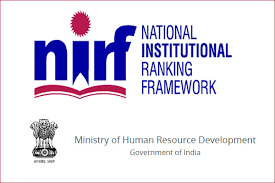Union Human Resource Development Minister Mr. Prakash Javadekar announced ‘India Ranking 2017’ based on National Institutional Ranking Framework.
Toppers of India Rankings 2017 (NIRF 2017):
| Category | College/Institute/University |
| Overall | Indian Institute of Science Bangalore |
| Engineering | Indian Institute of Technology Madras |
| Management | Indian Institute of Management Ahmedabad |
| Universities | Indian Institute of Science Bangalore |
| Colleges | Miranda House (Delhi) |
| Pharmacy | Jamia Hamdard (Delhi) |
- From this edition, the colleges have also been ranked.

- 800 new private and public institutions participated in this year’s survey.
- From this year, overall ranking category has also been added.
- Other domains viz. architecture, law, medicine etc. were also to be included this year. But owing to non-representative participation they were excluded.
For India Rankings – 2017, there has been no change in main ranking parameters. However, significant changes have been made in a few sub-parameters.
About National Institutional Ranking Framework (NIRF):
- On 29th September 2015, the National Institutional Ranking Framework (NIRF) was approved and launched by Union Ministry of Human Resource Development (MHRD).
- It is framework that outlines methodology to rank higher education institutions of India.
- A core committee was set up by MHRD to enlist broad parameters for rankings. The methodology adopted by NIRF is based on recommendations of this committee.
- First edition i.e. India Rankings 2016 were announced on 4th April 2016.
- More than 3000 private and public institutions had participated in the ‘India Rankings 2016’.
- Theses rankings are determining factor for institutions seeking Govt. funding. Institutes with better ranking are rewarded in terms of greater autonomy and more international exposure.
- The broad parameters of NIRF are as under:
| Parameter | Sub-parameters |
| Teaching, Learning & Resources | Student Strength including Doctoral Students |
| Faculty-student ratio with emphasis on permanent faculty | |
| Combined metric for Faculty with PhD (or equivalent) and Experience | |
| Total Budget and Its Utilisation | |
| Research and Professional Practice | Combined metric for Publications |
| Combined metric for Quality of Publications | |
| IPR and Patents: Filed, Published, Granted and Licensed | |
| Footprint of Projects and Professional Practice And Executive Development Programs | |
| Graduation Outcomes | Combined % for Placement, Higher Studies, and Entrepreneurship |
| Metric for University Examinations: GUE | |
| Median Salary | |
| Metric for Graduating Students Admitted Into Top Universities | |
| Metric for Number of Ph.D. Students Graduated GPHD | |
| Outreach and Inclusivity | Percent Students from other states/countries (Region Diversity ) |
| Percentage of Women | |
| Economically and Socially Challenged Students | |
| Facilities for Physically Challenged Students | |
| Perception | Peer Perception: Employers and Research Investors |
| Peer Perception: Academics | |
| Public Perception | |
| Competitiveness |
AffairsCloud Recommends Oliveboard Mock Test
AffairsCloud Ebook - Support Us to Grow
Govt Jobs by Category
Bank Jobs Notification





